The alarm went off at 3:30 AM and I woke up unsure of where I was but convinced I missed the boat. Of course I didn’t but it was a horrible time and way to awaken. I showered, brewed some coffee, and was off to Freeport for a See Life Paulagics trip on the boat Captain Lou VII. We departed at five, about fifty intrepid birders eager to see what the sea had to offer us.
It was still dark as the boat departed and kind of chilly. I cursed myself and the stupidity of wearing shorts but I really wasn’t that cold. In the clear dark night we could hear warbler flight calls overhead and wished they would land rather than continuing over the Atlantic and, likely, end with a watery death. Not the warmest of thoughts on a cool morning but waking at half past three tends to do that to you. As the sun rose we left Long Island behind us and started scanning for birds.
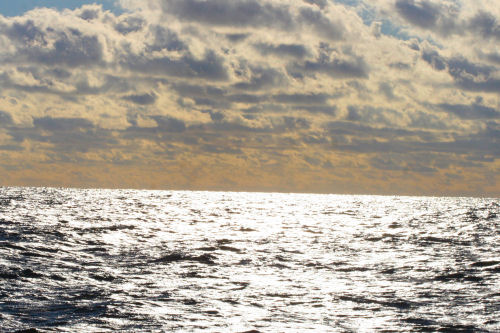
The first several sightings were of land birds flying north low over the water against the north wind, desperately trying to get back to shore. No fewer than four Northern Flickers were sighted, and a more incongruous sight than woodpeckers over waves I can’t imagine. We wished them good luck and kept scanning, spotting a single juvenile Northern Gannet, our first pelagic bird of the day. But we weren’t hoping for gannets or flickers, we wanted storm-petrels, jaegers and shearwaters!
A very distant fishing boat with gulls behind it caught our attention and most of the birders focused their bins there, hoping to pick something out of the gulls. I was not terribly optimistic about picking anything out at the edge of conjectural birding so I was lucky enough to spot a bird much closer in, off the starboard side, maybe a couple of hundred yards out, flying to the right. It was flying kind of like a tern, but it wasn’t like any tern I had ever seen. “Hey,” I thought to myself, “That probably means it’s a good bird.”
So I yelled “Bird at three o’ clock, flying right!”
And, lo and behold, a cry of “Long-tailed Jaeger” went up from several people at once.
A lifer! And a pretty darn rare bird, even on a pelagic! And I found it! Of course, I didn’t identify it, but that’s okay. We got a good long look at the bird and its field marks, which were explained by our leaders, and then started scanning again, which was pretty boring, but not as boring as my explaining the field marks to you would be. But the boredom was alleviated by a pod of Common Dolphins.
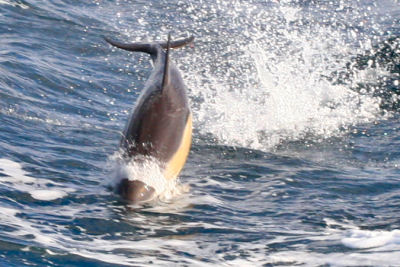
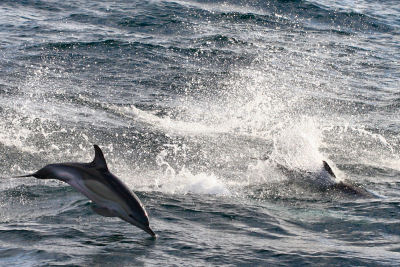
We soon outpaced the dolphins and continued steaming south, helped along by the still strong north wind. That same wind, unfortunately, helped keep the warmer water and most of the seabirds we wanted to see further south than expected, so we had another couple of hours without much to see at all. Well not much except for four phalaropes that flew by so fast that no one could tell if they were Red Phalaropes or Red-necked Phalaropes, a pod of Bottlenose Dolphins, and two “Comic Terns,” that is, terns that were too distant to distinguish if they were Common or Arctic. And we spotted a Mourning Dove and some Merlins flying north, as well as some unidentified little land birds. It must really suck to be a bird that can’t swim stuck out over the ocean!
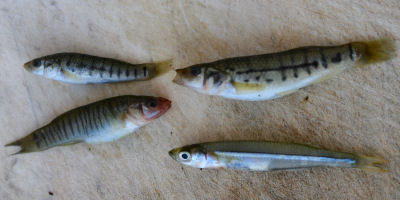
A variety of fish for bird bait. Anyone know what they are?
When we finally reached warm water we were immediately greeted by a small flock of Wilson’s Storm-Petrels. The little dark seabirds with the white rump were doing their distinctive foot-patter on the water and were a joy to see up close, especially considering that I’d only ever seen one from land before. We enjoyed them for awhile and pressed on, counting on finding more because they are usually a common bird at the Hudson Canyon, where we were, at this time of year. Turns out they were the only ones we’d see all day. Bummer.
Then it happened. Someone screamed “White-faced Storm-Petrel!”
Pandemonium ensued. Maybe four people saw the distant bird as it flew between waves. I wasn’t one of them. We turned the boat around, paralleling our fish-oil slick, hoping to refind the bird. No luck. It would have been a lifer for many on board so we spent quite some time looking for it until another yell, this one about an Audubon’s Shearwater at the front of the boat. About a third of the birders on the boat got on the bird and the rest of us were left rather unhappy. We couldn’t refind the shearwater either. Another Long-tailed Jaeger helped a bit but didn’t really cheer anyone up.
Finally, a cry of “Cory’s Shearwater” was raised and it cooperated, letting virtually everyone see it in all of its lazy-flying glory. It even landed and let us maneuver closer, but not really close enough for pictures (my camera spent most of the day packed away anyway, as there was a lot of spray, and, to be honest, I was afraid of losing my balance from the waves and having one of those “should I save the camera or my body?” split-second decisions to make).
But back to the life bird. My mis-spelled namesake is, to me anyway, kind of a goofy-looking shearwater that has a distinctively slow wing beat and a lazy demeanor (Yeah, go ahead and have fun in the comments). It also has a big yellow bill and a rather evenly colored mantle. And, despite the fact that another bird is called Greater Shearwater, Cory’s Shearwater is actually the biggest shearwater of all. I liked it. Mostly because of the name and the fact that it let me see it. And then a second one showed, and, while it was not as cooperative as the first bird, it was still seen by pretty much everyone.
On the way back we enjoyed looks at Risso’s Dolphins, otherwise known as Grampus, big, beakless beasts with tall dorsal fins and scars and scratches all over their backs. The scarring makes the older ones white. We also spotted two Loggerhead Sea Turtles and a Parasitic Jaeger.
Wait, was that Parasitic Jaeger? Yup. Another lifer. This bird was off the front of the boat and when it was spotted but not yet identified I rushed off of the top deck, where the front of the boat was crowded, to the bottom deck, which was deserted at the front because of the spray, and enjoyed absolutely wonderful views of the tough-guy bird. Having never seen any jaeger before the trip and managing to see two species was quite a treat.
The rest of the way in was rather quiet though when we were about a mile offshore a Peregrine Falcon shot past us heading southwest. Then we got into the gulls and terns that hang out just offshore. The sun was setting and it was gorgeous.

So, how was the pelagic trip overall? Well, prior to setting out I had five goals:
Actually, I have five goals besides not embarrassing myself: to see five lifers (which is actually possible as the “target birds” list for the trip contains eleven that would be lifers), to not succumb to chumming, to learn about seabirds, to have fun, and to be present for a first confirmed record of a bird in the Atlantic Ocean.
I met every goal except for seeing five lifers (I got three and missed two of the possible lifers seen on the trip) and having a first confirmed record of a bird in the Atlantic, which was a tad bit unlikely to begin with. But I learned about seabirds, avoided seasickness, and had a lot of fun. And that was what this the was about anyway, right? Having fun? These guys, the trip leaders, sure look like they had a good time.
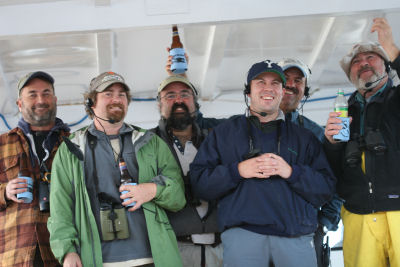
our fearless trip leaders (that guy in the yellow pants blogged the trip here)
The boat docked at 8 PM, I arrived at Daisy’s in Queens a bit before 9, and almost fell asleep while eating a delicious dinner. In the morning I woke up at 5 AM and got to work in Saratoga Springs on time! My New York Big Year list now stands at 284…16 to go!
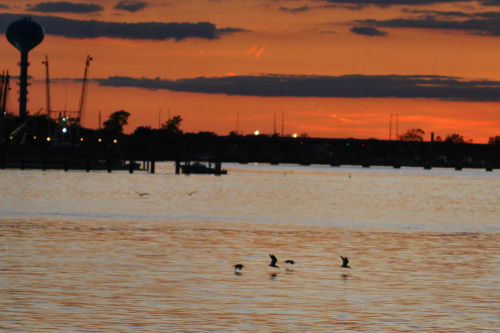
Black Skimmers after sunset.












Congrats on not puking. Someday I will over come my current fear of boats (I had one really bad experience) and get out there. But it won’t be tomorrow.
Wow, cool. Reading this post stirred up many memories of Cape Cod. I want to go back!
Nice report. I went on a pelagic this weekend too in North Carolina and got a lot of different stuff. Amazing what a difference a few hundred miles makes.
I’ve been on one winter pelagic and a few whale watches. Next year, I’ll hopefully get out in the summer. It looks like you had a pretty awesome time and saw some cool birds. Too bad about those misses. Boats + waves + lots of people can be difficult. I heard it was 7 hours out and 7 hours back. God bless you on that one. Yikes.
When are we heading to North Carolina or Monterey? 🙂